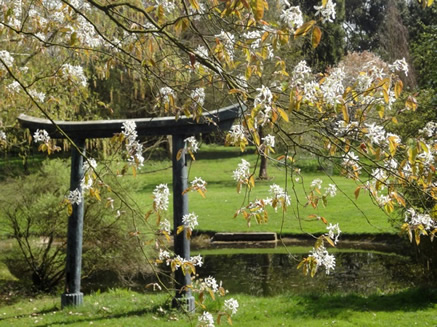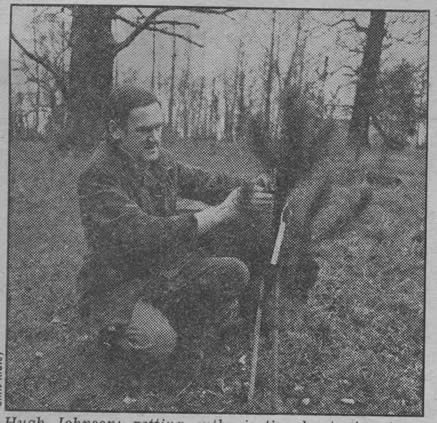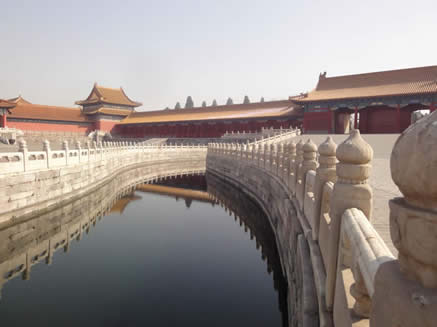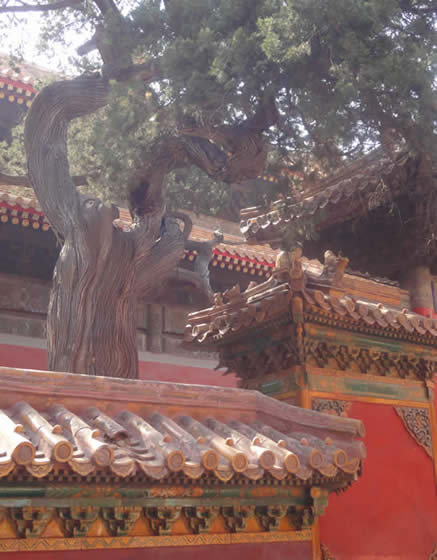Water fight
4 May 2011
Each time the rains dry up in spring just as the plants push out their sappy shoots I puzzle over what must be happening underground. Is it the big fat powerful-looking roots that elbow weaklings aside and suck up the dwindling moisture in the soil, or is it the fine thread-like roots in their masses that win the greater share? I suspect the threads, with their much greater surface area, do better in separating what water there is from its adherence to soil particles.
How they can keep supplying multiplying leaves with the liquid they need is beyond my imagination. The suction in each stem is transmitted to each minute rootlet - which has its own
Oh, to be in England
27 April 2011
It is a comfort to read that there have been years like this before, when summer arrived before the cuckoo. 1893 broke all records for a racing start. In the South of England there was no rain from the end of February to the middle of May. Record temperatures telescoped spring into summer - and summer went on in the same spirit. 1893 was followed by seven years of drought (and 1894 saw record low winter temperatures). But what can you learn from a mere decade or so of seemingly consistent patterns of weather?
This year there have been only a scattering of drops since the last days of February, and April has been the hottest since heaven knows when. One record has been broken which I expect never to happen again: our champion crab apple, the Malus baccata from Siberia that crowns the churchyard gate from our front park with a dome the size of a small Orthodox church was in full flower on
Don't dither
18 April 2011
'Faites simple' (was it Voltaire who said it? Or Escoffier?) is often quoted as the soundest, the most essential, stylistic advice. Keep it simple. What does it mean to a gardener? I picture spaces in perfect proportion, a theme of brilliant relevance, an ideal triad of colours, a single tree, or urn, or rock placed precisely to balance a distant spire or crag.
From Japan
17 April 2011
I have had an almost heart-breaking message from a correspondent in Japan. The city of Rikuzentakata, she tells me, was protected from the ocean winds by an ancient forest of 70,000 black and red pines. After the tsunami on March 11th one single tree was left standing. 'Resin oozes from the trunk where the lower branches were ripped off by the power of the waves, but a thick spray of green needles at the top of the 10 metre tree shows it is very much alive'. Nearly 2,500
people in Rikuzentakata perished
Unseemly scramble
11 April 2011
Surely it isn't even legal, let alone customary, to have peach trees, pears and apples flowering at the same time. (Except, that is, at Chelsea.) What is 'Star Wars', that far from bashful magnolia, doing flowering alongside my peach tree? Indeed, why is my peach still at it, having started flowering in February? This is not season creep but season leap.
The cherries are all flowering together, bar the earliest. But so are the pears from my crusty old Bergamotte d'Automne, now a fifty-footer, to the designer -model Pyrus salicifolia, a ten-foot dome of aluminium leaves and beguiling cream flowers. The apple trees are showing a shy flower or two, the crabs (John Downie in particular) much more than that. Meanwhile the hedges are a foam-bath, dazzling white, of the blackthorn that proclaims bitter weather.
Whatever message the oaks and ashes bring has surely never been more emphatic. The oaks are showing the tender olive green of their emerging leaves while the ashes are still bare black tracery. I fervently hope they are in a muddle too. We have had no rain since the end of February: without a soak we are in trouble.
It is hard to say how much would have happened on the ground if it had rained: how far out should the roses be in the second week of April? Herbaceous
Stay your hand
1 April 2011
It's tempting, isn't it, to poke around in and under a plant showing dead-parrot symptoms: leaves scorched or absent, scratched bark brown where green cambium should be, no incipient buds or shoots from the base? There are some, after the fierce blasts of December and days at -12° Centigrade. March days like summer have only emphasised how very brown and dead they look; all the more important to be patient; clear away unsightly wreckage but defer decisions about digging out the roots. Even plants you consider borderline for hardiness may yet surprise you.
As my favourite Francoa ramosa, the saxifrageous bridal wreath from Chile,
Flashback
31 March 2011
The grainy old photo on the right appeared in The Radio Times in January 1974. The tree I am planting is a Monterey pine (it seems I was obsessed with pines, then as now) which, 37 years later, is a 60 foot monster with a similar wingspan. I found the cutting as I was clearing out old papers and reproduce it here in case anyone is still labouring under the delusion that it's not worth planting small trees because you'll never see them in maturity. Also as a warning: Pinus radiata is not a good choice for a garden of less than a couple of acres.
In the background on the left is one of the huge elms that started to die that very year.
Soundtrack
28 March 2011
Music permeates every television programme. It tinkles and swoons and crashes (often drowning the accompanying words) following some unknown law of appropriateness. What authority decrees what music, on what instruments, familiar or new-minted, jaunty or drowsy, is to colour our perception or guide our mood as we watch the pictures?
The twinkling galaxies and molten nebula of Wonders of the Universe come with properly portentous orchestral drama in one sequence;
Eastward in Eden
22 March 2011
Back from China, excited and jetlagged. Beijing was still grey with winter, raw, yellow-hazy and smelling of pollution, but throbbing with life. The Chinese seem to live faster, louder, more Italianly than other races. You see more smiles - or am I just a romantic traveller?
At last, on a second attempt, I saw The Forbidden City. Versailles, Schönbrunn, the Kremlin …….eat your hearts out. There is no palace to compare.The scale, the spaces, the wide sky, the variations in a consistent style of building deserve the word awesome, however you pronounce it.
The Colossal rectangle, within its two miles of stone-built moat an arrow-shot wide, progresses from larger courts to smaller ones. The first vast space, the Outer Court, is traversed by the meandering Golden Water River, crossed by five stone bridges and lined with pale stone culminating in carved bosses. In the centre is the Hall of Supreme Harmony, 125 feet high. There are no trees, no plants, no shade, nothing green. The floor is brick.
The Inner Court is smaller and more complex, with more buildings and more subdivisions, but still no trees. It must be a punishing place in summer to parade and process, or go emperor-visiting.
You penetrate further, more marble steps and ramps, more pavilions: still no green. At last you come to the emperor's residence. Behind it, cloistered and gated, lies his garden.
The impression it gives is that the intimacy and luxury of a garden are something private, reserved for family and friends. I have always found the freakish contorted rocks of important Chinese gardens hard to enjoy. Where the Japanese choose stones softened by the ages and deploy them (not always, but usually) in harmonious naturalistic groups, the Chinese try to evoke the crags of the Yangtze gorges that figure on so many painted scrolls. Without, it seems to me, much success.
But suddenly, in the palace garden, the pavilions grow gorgeous, their roofs
Back to previous Trad's Diaries |
needs to keep it growing, too. The forces at work to keep every shoot and leaf turgid and functioning are awesome.
There has not been a millimetre of rain here since the scattering we had in March: the five weeks of the year with the greatest demand for water have been supplied entirely from moisture held in the soil by surface tension - and yet I hardly see a limp or drooping shoot.
Certainly growth has been slowed down. I started watering perennials a week ago. Aruncus sylvester (already with flower buds) quickly shot up to three times the height. Delphiniums looked as if they are about to flower at knee height; watering has made things a little better. A young Magnolia 'Star Wars', which always seems to overdo its flowering, had scarcely a leaf two weeks ago but fifteen flowers. A can of water a day and it presents a much more balanced picture of flower and leaf. Does localized watering with cans create bedlam below as every rootlet smells water and heads into the damp zone?
Easter Sunday. Only the latest Easter possible (this year it coincided with the Orthodox one) married to the earliest spring we have ever seen could bring this off. Village brides timing their wedding for the crab apple reckon on mid to late May for the photo among its enfolding white boughs.
I set out on Easter morning to list all the flowers in the garden, but soon gave up. It meant listing almost everything that flowers in spring. The back-marker, to my surprise, is the hawthorn in the hedges, just breaking its flower buds with the promise of a deluge of foamy white to follow the magnolias, the cherries and even the crab apples.
Climbing roses have been slightly delayed, it appears, by the long cold winter. The Banksian rose is on schedule, though; a thick yellow blanket around our bedroom windows on the west wall. Gloire de Dijon is tentatively opening on the same wall and Maigold's first flowers, a bit anaemic compared with its usual brilliant orange, are just appearing. Rosa moyesii is also firing up.
Never has the ash been so far behind the oak. The elm, too, which in Browning's April is in 'tiny leaf', has held back. The oak apart, it seems, our native trees have been less impressed with the premature heat wave than the exotics of the garden.
Simplicity - and boredom. How often can you admire the designer's judgement? The greatest designs have authority, true, which rarely comes from over-complication. You certainly remember a decisive garden better than one made by a ditherer. What Voltaire (or Escoffier) meant, or I hope he meant, is not cut out the fiddly bits, but know what you are aiming for and go for it. Evident intent, consistently pursued, is the winning formula. Decide what you want, and if you are side-tracked clamber back to your original plan as quickly and as gracefully as you can.
in the tsunami. 'I can't even remember what the town looked like, said one resident; 'it is so completely gone'. The lone pine is now the symbol of their resolution to rebuild.
'Overwhelmed by the images of destruction', writes my pen friend, 'I decided to watch Monty Don's programme which I had recorded the evening before the earthquake and had not seen. I could not take my eyes off him. He had a glorious smile, prancing towards the Alhambra. I realized I had not seen a smile in days, that people smile when they are doing what they enjoy, and I felt it was alright to smile again'. 'I must switch off my computer now to conserve electricity. Please turn yours off too, step outside and celebrate everything and everyone around you. No power source required'.

Short-lived but lovely: Amelanchier laevis at Saling
plants are holding back. Early flowerers are flowering without growing; I am looking at a clump of perennial honesty that should be at least two feet high when it starts to flower. It is barely one foot. Weeds, on the other hand, are mercifully quiescent too.
Bulbs are in the same plight. Bluebell clumps are small and stunted, showing a few desultory flowers. As for daffodils, they have scarcely opened before they start to shrivel; the idea of an organized sequence has gone by the board. One of the last, and prettiest of all, my favourite 'Thalia', a duet of delicate white flowers on each stem, is already looking jaded.
Spring is always a hurry. I regularly complain I need more time to take it all in. But this year reminds me of New England: blink and you've missed it. Whatever am I doing sitting scribbling indoors?
did yesterday. My secateurs were poised, cutting away brown desiccated shoots, when a speck of pale green on the ground told me not to be so hasty. It feels like summer this afternoon, but March is early spring. I have gone back to dividing thriving green clumps, while wondering how much of the horrible-looking bay tree in the yard we will loose, and how much to chop off now for aesthetic reasons. Oddly, its south face (it is 30 feet high) is scorched while its north face is still green. A friend suggests that it is the paved surface of the yard under it that is to blame. It must have been a block of ice for three or four weeks.
There will be plenty of anomaly anecdotes when we come finally to count the losses. A nurseryman friend has lost almost every Chilean and Kiwi plant in his unheated tunnels. No hebes, abutilons, hoherias ……. it’s a long list. They may not be dead, but they are not fit for sale. Why was he smiling? 'Just you wait', he said. 'Everybody's lost them, but it won't stop them coming back for replacements'.

spooky pop in another. The modest share of teletime devoted to gardening calls for sweet airs or inconsequential doodling. My question? What background music do you envisage for your own garden? Is it Beethoven's Pastoral Symphony or Whistle while you Work? Is it Greig or Gounod, Mozart or Mendelssohn?
I know what my choice is for mine: birdsong. I have been sadly inattentive to it in the past. I still worry whether it's a robin or a wren, a blackbird or a thrush that raises my spirits and unites me with the morning. And now I realize that it's getting late; I should have paid more attention while I could; age claims our hearing, and the dawn chorus no longer wakes me. I struggle to tell what birds are singing in what trees; where once their cheeps and trills and whistles penetrated my soul I struggle to follow them. When I get a hearing aid it will be to listen properly to my garden.

The golden Water River

Privacy: the Emperor's garden
elaborate, their eaves gilded. Beds of paeonies line the walks under ancient trees.
There are pots of flowers, and flowering trees, and trees sculpted to look like embroidery. There is joy in artifice, and joy in nature. In all the pomp of ultimate power, the garden is the ultimate pleasure.
|